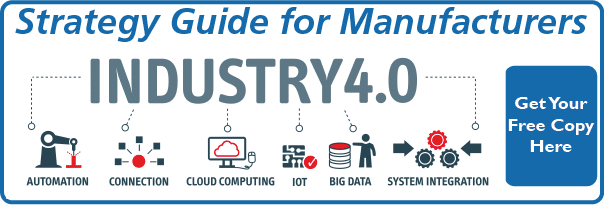
It's Cheaper to Retain a Customer than to Win a New One
We can debate the relative cost, but the premise is widely accepted. Given that, why is our industrial marketing to existing customers so poor?
In my frequent conversations with middle market industrial manufacturing firms I hear lots of purring about loyalty, repeat orders and service.
But when I ask about lifetime value, how many contacts are in the database (before we even get to bounce rates and data hygiene,) and what sort of ongoing communication they cultivate with buyers, then suddenly the conversation hits a wall.
It's a common situation.
- Lots of attention is paid to acquiring new customers.
- Once over the finish line then the relationship changes - it's now a series of unrelated interactions and transactions with support and service functions
Where's the breakdown?
The silo structure of most manufacturing companies leaves them unable to embrace the sort of ongoing industrial marketing and nurturing of existing customers that they're gradually beginning to try with prospects. (Here's my 10 minute video/whiteboard explanation of the challenge.)
Industrial manufacturing firms often tell me:
- customer contacts are in an ERP/accounting database which is different than the sales database
- those are often just billing (e.g. AP) contacts
- they don't have any mass email system, and wouldn't email customers because that would be spam
- they don't know how many contacts they have, and of course therefore have no idea how many valid email addresses are included
- they wish they had better relationships with buyers (sales channel, different buyers than users and various other excuses justify the shortcoming)
- yet they also tell me that their customers are extremely loyal
Jeff Gitomer is often cited for his assertion that:
The single most valuable asset that you, or your company, will possess over the next 50 years will be your email mailing list. Keep building it, and guard it with your life.
So where's the rub? If this is key to industrial marketing and revenue growth success, why do manufacturers insist they've enveloped all their customers in this warm embrace of mutual love...while their actions demonstrate disregard?
Orphan Accounts
Let's make the reality simple. Once a sale is complete, payment is made and the start-up is successful...everyone heads off in different directions.
Sales people look for their next sale. Operations folks are planning the next build. Service folks are waiting for the next call. Parts people are busy trying to cross reference hand drawn blueprints to find a replacement for an old machine.
And the buyer is back to running their business.
And then people change roles, leave the company, retire, etc. Suddenly those casual, transactional relationships are lost....and accounts (or machines in the capital equipment sales world where many of my clients operate) become orphaned.
Sure, you probably left a sticker on the machine with your URL...but even the operators manual is probably lost within a couple weeks.
So what's the answer? A long-term mindset shift that's got to be articulated and reinforced by management.
When that management commitment is clear, then these seven industrial marketing steps will help to tactically support the effort.
7 Tips to Actually Build the Customer Relationships You Claim to Have
- Set a goal to have contacts from at least 5 different departments for each sale
- Integrate your contact database
- Segment rigorously
- Email monthly
- Publicly track "adoptions"
- Create content around ongoing problems
- Create community
1. Grow you contact reach
Team buying is common in complex sales today. Engineering, management, finance, HR, maintenance & purchasing are involved in most capital equipment deals. The departments may vary by your product (you might even have to deal with IT!) but the point is there are multiple perspectives. You should be creating sales enablement content for the entire buying team, and recognize that their long-term success metrics are different.
So you'll want your customer database to reflect that diversity of roles and perspectives. If you sell through channel you'll have to build this over time, through interactions. Make sure that tech support, spare parts, customer service and finance people all are clear on why they need to help build the database, and even how to ask. There's no reason that a field service technician can't bring back business cards for shift supervisor, maintenance manager, plant engineer and maybe plant manager. Similarly when someone calls with a support question, it's easy to ask and capture the details for the person who called.
2. That only works if you integrate your database
Individual Outlook .ost files don't count. Pick one location - whether it's your ERP or your CRM isn't so important. Simply make sure that there's a single database which is the go to resource. Use API integrations to sync the information to other systems if necessary.
That steno pad by the phone of your parts manager? Great tool to help him/her quickly capture important details, but it's not the final resting place of valuable additional contact details. Your sales reps' LinkedIn accounts? InMail can be a great prospecting tool, but they're being paid to build your business - you own the contacts. Don't leave yourself vulnerable to them leaving with your data, or tragically dying in a car accident and leaving you stranded.
And then help departments collaborate. Before your sales person calls, wouldn't it be good if they saw that yesterday someone called for tech support and your AR folks made a dunning call?
3. Understand who wants what
The finance contacts don't care about how to reprogram a PLC, just as maintenance doesn't care about how proposed changes in 179 accelerated depreciation might make a significant difference in capital investment in December vs. January.
Understand the perspectives and differentiate between them in your database
4. Create content for them....NOT for YOU!
Understanding the difference in their perspectives, and researching (NOT assuming) the questions they're asking in their day to day work (not just when they're in the market for a solution like yours) let's you develop and provide information that they'll appreciate. It should help them do their job better every day, month and quarter - and only occasionally reference your solution.
5. Email monthly
It's not enough to build the muscle - you've got to exercise it. Email your list monthly, and make sure it's likely helpful to them and appropriately targeted by segment. It's OK to make a brief mention of news, trade shows, etc - but that's all got to be secondary to your content for them....not about you.
Emailing regularly let's you catch them at the right time, and gradually foster a connection. Additionally it lets you gradually improve your list and deliverability. Don't just blast emails at a set time - invest in individualized deliverability optimization.
Of course you'll track email metrics (deliverability, bounce, unsub, open & click rates) but also track how many website pages they visit as a result, how many new contacts you create (through forwarded mails) and how many responses you get. The ultimate metric? Sales that can be tracked back to your customer nurturing campaigns.
6. Track "adoptions" as a company KPI
In capital equipment sales it's common that machines are sold through sales channel, ship, and manufacturers never know where they went. Sadly there are also situations where direct buyers gradually lose touch.
Create KPIs around reengaged companies (perhaps where last interaction was > two years ago) or around new machines uncovered in the field.
Publicize those, recognize the industrial archaeologists that found them, and then step it up a notch tracking revenue created from those accounts within the next 12 months. That's found money!
7. Create community
User forums and LinkedIn groups each serve a function. But that's not where energy is going today.
Create a closed Facebook group for users of your product / service. If you've got very different user types (e.g. engineering and HR) you might create multiples - but start with one.
Now, I hear you. "That will never work. Our buyers/users aren't going to interact with us on Facebook."
You're right. Since you're not going to do it anyway, it will never work.
If you do try it, it will take time and some moderation...and it might not work. But I'd be willing to bet that even with classic industrial products you'd be surprised....I suggest it could work.
Long-term Payoff
What's the value of doing this? Aside from more sales (training, upgrades, add-ons, parts, service, replacements, horizontal products) business valuation increases. Documenting a process and confirming with metrics that it delivers revenue, consistently over time, is the foundation for justifying a lower discount today on the valuation of future revenue.
Plus it makes business a whole lot more fun if instead of looking for every deal new, you smooth out some of the traditional cycles with consistent revenue.
Buyers are happier - you're consistently helping them do their jobs better by sharing trends, insights, tips and expertise. They'll value you as a collaborator rather than lump you in with others as a vendor.
For many companies it's a step closer to actually living the values which they promote - really caring for and engaging customers.
Want to explore more ways that industrial manufacturers can be shaping their strategy for future success? Download this free guide for a question and discussion roadmap to help.



